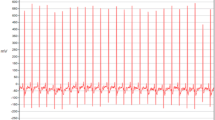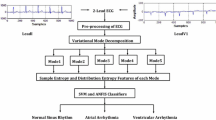Abstract
In the present study, it has been shown that an unnecessary implantable cardioverter-defibrillator (ICD) shock is often delivered to patients with an ambiguous ECG rhythm in the overlap zone between ventricular tachycardia (VT) and ventricular fibrillation (VF); these shocks significantly increase mortality. Therefore, accurate classification of the arrhythmia into VT, organized VF (OVF) or disorganized VF (DVF) is crucial to assist ICDs to deliver appropriate therapy. A classification algorithm using a fuzzy logic classifier was developed for accurately classifying the arrhythmias into VT, OVF or DVF. Compared with other studies, our method aims to combine ten ECG detectors that are calculated in the time domain and the frequency domain in addition to different levels of complexity for detecting subtle structure differences between VT, OVF and DVF. The classification in the overlap zone between VT and VF is refined by this study to avoid ambiguous identification. The present method was trained and tested using public ECG signal databases. A two-level classification was performed to first detect VT with an accuracy of 92.6 %, and then the discrimination between OVF and DVF was detected with an accuracy of 84.5 %. The validation results indicate that the proposed method has superior performance in identifying the organization level between the three types of arrhythmias (VT, OVF and DVF) and is promising for improving the appropriate therapy choice and decreasing the possibility of sudden cardiac death.






Similar content being viewed by others
References
Kaltman JR, Gaynor JW, Rhodes LA, Buck K, Shah MJ, Vetter VL, Madan N, Tanel RE (2007) Subcutaneous array with active can implantable cardioverter defibrillator configuration: a follow-up study. Congenit Heart Dis 2(2):125–129
Wilkoff BL, Kühlkamp V, Volosin K, Ellenbogen K, Waldecker B, Kacet S, Gillberg JM, DeSouza CM (2001) Critical analysis of dual-chamber implantable cardioverter-defibrillator arrhythmia detection: results and technical considerations. Circulation 103(3):381
Mishkin JD, Saxonhouse SJ, Woo GW, Burkart TA, Miles WM, Conti JB, Schofield RS, Sears SF, Aranda JM Jr (2009) Appropriate evaluation and treatment of heart failure patients after implantable cardio-verter-defibrillator discharge: time to go beyond the initial shock. J Am Coll Cardiol 54(22):1993–2000
Thakor NV, Zhu YS, Pan KY (1990) Ventricular tachycardia and fibrillation detection by a sequential hypothesis testing algorithm. IEEE Trans Biomed Eng 37(9):837–843
Arafat M, Chowdhury A, Hasan M (2011) A simple time domain algorithm for the detection of ventricular fibrillation in electrocardiogram. Image Video Process 5:1–10
Jekova I, Krasteva V (2004) Real time detection of ventricular fibrillation and tachycardia. Physiol Meas 25(5):1167–1178
Anas EM, Lee SY, Hasan MK (2010) Sequential algorithm for life threatening cardiac pathologies detection based on mean signal strength and emd functions. Biomed Eng Online 9:43
Kuo S, Dillman R (1978) Computer detection of ventricular fibrillation. In: Proceedings computers in cardiology, pp 2747–2750
Barro S, Ruiz R, Cabello D, Mira J (1989) Algorithmic sequential decision making in the frequency domain for life threatening centricular arrhythmias and aimitative artifacts: a diagnostic system. J Biomed Eng 11(4):320–328
Dzwonczyk R, Brown CG, Werman HA (1990) The median frequency of the ECG during ventricular fibrillation: its use in an algorithm for estimating the duration of cardiac arrest. IEEE Trans Biomed Eng 37(6):640–646
Zhang XS, Zhu YS, Thakor NV, Wang ZZ (1999) Detecting ventricular tachycardia and fibrillation by complexity measure. IEEE Trans Biomed Eng 46(5):548–555
Amann A, Tratnig R, Unterkofler K (2007) Detecting ventricular fibrillation by time-delay methods. IEEE Trans Biomed Eng 54(1):174–177
Li H, Han W, Hu C, Meng MH (2009) Detecting ventricular fibrillation by fast algorithm of dynamic sample entropy. In: Proceedings IEEE international conference on robotics and biomimetics, pp 1105–1110
Balasundaram K, Masse S, Nair K, Umapathy K (2013) A classification scheme for ventricular arrhythmias using wavelets analysis. Med Biol Eng Comput 51(1–2):153–164
Li Q, Rajagopalan C, Clifford GD (2014) Ventricular fibrillation and tachycardia classification using a machine learning approach. IEEE Trans Biomed Eng 61(6):1607–1613
Alonso-Atienza F, Morgado E, Fernández-Martínez L, García-Alberola A, Rojo-Álvarez JL (2014) Detection of life-threatening arrhythmias using feature selection and support vector machines. IEEE Trans Biomed Eng 61(3):832–840
Goldberger AL, Amaral LAN, Glass L, Hausdorff JM, Ivanov PC, Mark RG, Mietus JE, Moody GB, Peng CK, Stanley HE (2000) PhysioBank, physiotoolkit, and physionet: components of a new research resource for complex physiologic signals. Circulation 101(23):e215–e220. http://circ.ahajournals.org/cgi/content/full/101/23/e215
Cho WH, Baek S, Youn E, Jeong M, Taylor A (2009) A two-stage classification procedure for near-infrared spectra based on multi-scale vertical energy wavelet thresholding and SVM-based gradient-recursive feature elimination. J Oper Res Soc 60(8):1107–1115
Koulaouzidis G, Das S, Cappiello G, Mazomenos EB, Maharatna K, Puddu PE, Morgan JM (2015) Prompt and accurate diagnosis of ventricular arrhythmias with a novel index based on phase space reconstruction of ECG. Int J Cardiol 182(1):38–43
Ropella KM, Baerman JM, Sahakian AV, Swiryn S (1990) Differentiation of ventricular tachyarrhythmias. Circulation 82(6):2035–2043
Ciaccio EJ, Coromilas J, Wit AL, Garan H (2011) Onset dynamics of ventricular tachyarrhythmias as measured by dominant frequency. Heart Rhythm 8(4):615–623
Masse’ S, Downar E, Chauhan V, Sevaptsidis E, Nanthakumar K (2007) Ventricular fibrillation in myopathic human hearts: mechanistic insights from in vivo global endocardial and epicardial mapping. Am J Physiol Heart Circ Physiol 292(6):H2589–H2597
Samie FH, Berenfeld O, Anumonwo J, Mironov SF, Udassi S, Beaumont J, Taffet S, Pertsov AM, Jalife J (2001) Rectification of the background potassium current: a determinant of rotor dynamics in ventricular fibrillation. Circ Res 89(12):1216–1223
Ten Tusscher KH, Mourad A, Nash MP, Clayton RH, Bradley CP, Paterson DJ, Hren R, Hayward M, Panfilov AV, Taggart P (2009) Organization of ventricular fibrillation in the human heart: experiments and models. Exp Physiol 94(5):553–562
Thomas SP, Thiagalingam A, Wallace E, Kovoor P, Ross DL (2005) Organization of myocardial activation during ventricular fibrillation after myocardial infarction. Circulation 112(2):157–163
Author information
Authors and Affiliations
Corresponding author
Ethics declarations
Conflict of interest
None of the authors has a conflict of interest.
Appendix: Fisher criterion
Appendix: Fisher criterion
Fisher criterion measures the ability of the jth feature to separate between two sets of labeled data (positive and negatives instances) by computing the F-score as.
where μ(y±)=μj,±−μj represents the difference between the average of the jth feature for the positive/negative classes μj,± and the whole set of samples μj. In the denominator, σ2 (y ±) is the sample variance of the positives/negative instances and can be calculated as.
where n± is the number of positive/negative samples. The larger the value of F(j), the more likely this feature is discriminative.
Rights and permissions
About this article
Cite this article
Weixin, N. A novel algorithm for ventricular arrhythmia classification using a fuzzy logic approach. Australas Phys Eng Sci Med 39, 903–912 (2016). https://doi.org/10.1007/s13246-016-0491-5
Received:
Accepted:
Published:
Issue Date:
DOI: https://doi.org/10.1007/s13246-016-0491-5




